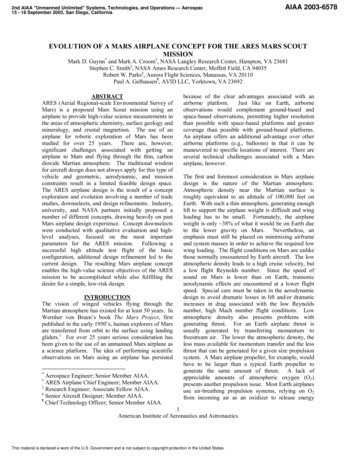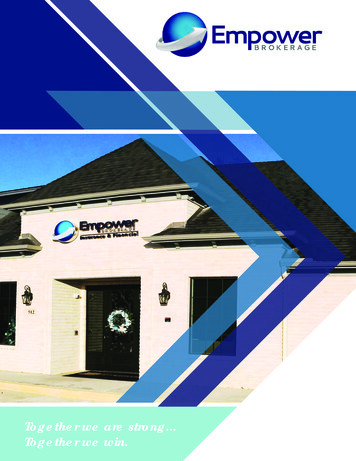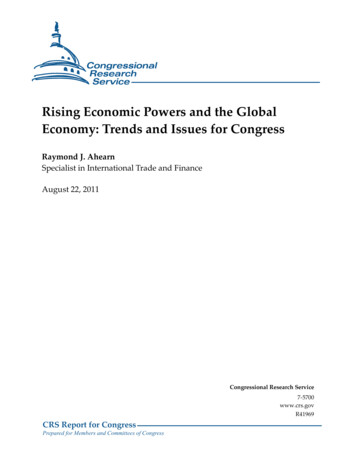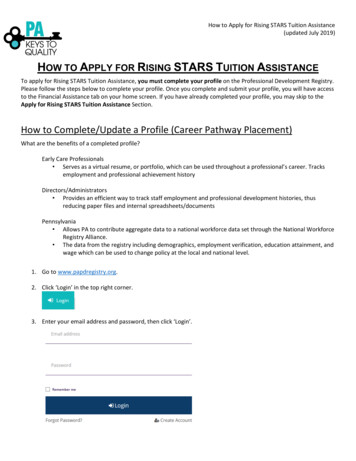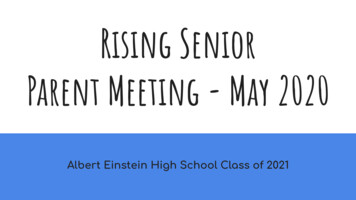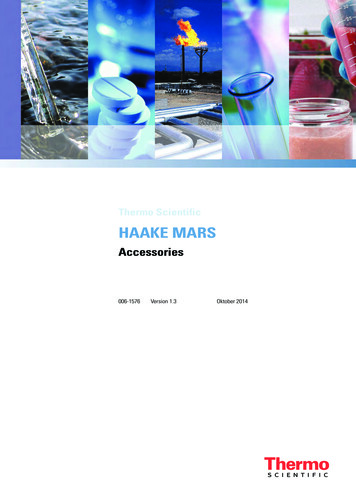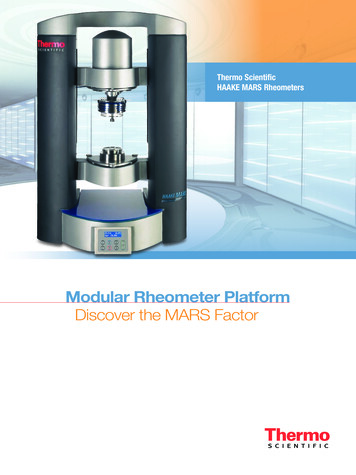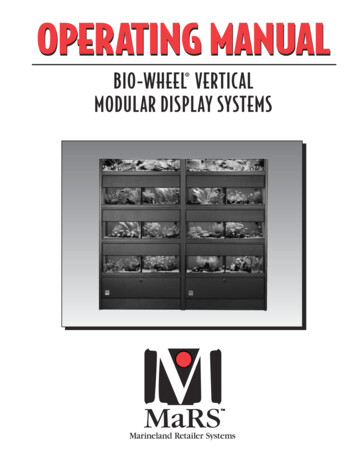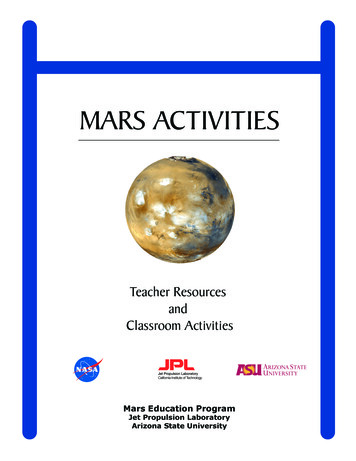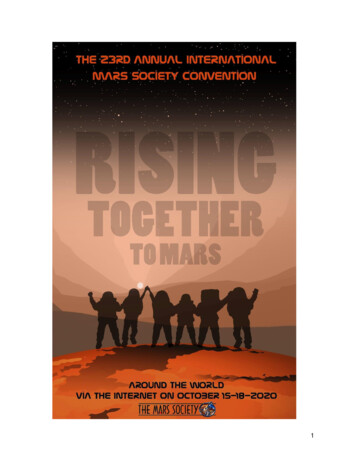
Transcription
1
"RISING TOGETHER"The 23rd Annual InternationalMars Society ConventionOctober 15-18, 2020An Online Virtual Event with the World's Top Mars Leaders and ExpertsThursday October 15th, 2020All TimesPDTMorning Plenaries9:00 AMDr. Robert Zubrin, President, The Mars Society9:30 AMDr. Chris McKay, NASA Ames, Prerequisites to Human Activity on Mars10:00 AMDr. Carol Stoker, NASA Ames, Potential Habitats for Life on Mars10:30 AMDr. Michael Hecht, PI, MOXIE, Mars Perseverance11:00 AMDr. Abigail Fraeman, Deputy Project Scientist, Mars Curiosity11:30 AMDr. Mark Panning, Project Scientist & Co-Investigator, Mars InSight12:00 PMDr. Adrian Brown: Mars 2020 and Mars Sample Return12:30 PMDr. Anna Yusupova, IBMP Russia: confinement experimentsAfternoon SessionsTech A1:00 PMTech BTA-1 Romanko et a:l TB-1 Gilbert: NuclearOasis Mars Project Fuel Cycle for MarsSA-1 Bhuiyan: MarsCity Design for1,000,000MedicalM-1 Kir: Medicine onMars after 2050M-2 Gardiner:Towards HealthyLiving on Mars in aTime of CV19 onEarthTA-2 Lee Roberts:Underwater MarsHabitatsSA-2 HaeupliTB-2 Nikitaev: SeedingMeusburger: MarsH2 in NTP EnginesScience CityTA-3 AnastasiaProsina: StellarAmenitiesSA-3 Jus Ad Astra:TB-3 Tan, Rezende etHuman Rights as aM-3 Jobin: Martianal Operations of afoundation for a Mars Mental HealthPower Station on MarsBill of rights1:30 PM2:00 PMSettlement A23rd Annual International Mars Society Convention October 15-18, 2020Page 2
TB-4 Kumar, Sharma etSA-4 Mayes: Utopianal: Power GenerationColonies on Marsfor Mars using CO2TA-5 Lebedev:Alternatives todrilling using wartechnologyTB-5 Kumar, Adlakhaet al: Next Gen powerfor Martian lifeSA-5 Calanchi: Acultural andecological approachto Mars ColonizationM-5 Kommareddy andRezende: BoneDensity Stabilizer forLong Term SpaceTravelTA-6 Tompkins:GrowMarsExpanding LoopProcessSA-6 Gaviraghi et al:TB-6 Cooper: 2032 the The Martian Urbanfirst humans on Mars Cell as the unit forMartian settlementsM-6 Wong, Wu,McEwan: Noninvasive biomonitorfor human spaceflight2:30 PM3:00 PM3:30 PM4:00 PM4:30 PMM-4 Lordos: LargeScale SpaceSettlements: A NewFrontier for SpacePsychologyTA-4 Pelc, Suscickaet al; Evolution of aMars ColonyTA-7 Rezende, Souza TB-7 Saranya:et al: DeployingSanitation in a MarsGreenhouse facilities HabitatM-7 Radstake et al: InSA-7 Nebergall: Solarvitro models toSystem Miniunravel interplay ofSettlements in 2060spaceflight stressorsTA-8 Kacha, Sia:deployable MartianHabitatSA-8 Tellez et al: Thepreservation andM-8 Pelc et al:coexistence of human Hospital on the mooncolonies on MarsTB-8 Isenberg:Areomorphology byPlasma Processes?Break / Dinner Hour (5pm - 6pm)Thursday Evening Programs6:00 PMDr. Vandi Verma, Rover Driver - Mars Perseverance, Curiosity, Spirit, Opportunity6:30 PMDr. Farah Alibay, Systems Engineer, Mars InSight - Engineering Perseverance7:00 PMReid Stowe: Mars Ocean Analogs: Learning How to explore Mars at Sea7:30 PM8:00 PM8:30 PM9:00 PM9:30 PM10:00 PMMars Desert Research Station Panel - Dr. Shannon Rupert & crewmembersDr. John Grunsfeld, Astronauts Can Do Great ScienceUniversity Rover Challenge Panel - Kevin SloanMars University Panel - Kolemann Lutz23rd Annual International Mars Society Convention October 15-18, 2020Page 3
Friday October 16thAll TimesPDTMorning Plenaries9:00 AMDr. S. Pete Worden, Breakthrough Initiatives9:30 AMNick Booth & Elizabeth Howell, Co-Authors, Book: "The Search for Life on Mars" (2020)10:00 AMDean Cheng, The Heritage Foundation, China in space10:30 AMMichael Griffin, Former Administrator, NASA11:00 AMDr. Nathan Putzig, Exploring Mars with Ground-Penetrating Radar11:30 AMDr. David Poston, Space Nuclear Power12:00 PMRick Tumlinson, The Spaceflight Revolution12:30 PMKelvin Manning, Associate Director, Kennedy Space CenterAfternoon SessionsTech CTech DSettlement BOutreach & EducationTC-1 Zlindra et al:1:00 UBC Mars ColonyPMTD-1 Matkowski:Simulation ofEvacuation in MartianConditionsSB-1 Sobocinski: Pawnson MarsO-1 Melton: Spread theWordTC-2 Smith: SPORE:Resource Extractionand habitable space1:30creationPMTD-2 Chase:Psychological andSB-2 Nebergall:PhysiologicalParaterraforming Hebesimplications of Settling ChasmaMarsO-2 Charrek: The MarsSociety Education andOutreach Team FocusTD-3 Doug Shull: LunarTC-3 Pazar: ResourceSB-3 Gaviraghi: Marslava Tubes Show theTerraforming2:00 Utilization on MarsWay to MarsPMO-3 Burk and Crossman:Marspedia.org - 2020Progress Report &Tutorial DemoTC-4 Cadet et al:2:30 Mars, a buildablePM planetO-4TD-4 Green: RoboticSB-4 Shankar et al:Testing for Space SuitLaunch Center on MarsJointsTC-5 Singh andTD-5 Lofqvist:Shariq: MaterialIntelligent Swarms on3:00 properties of MartianMarsPM concrete3:30PM4:00PM4:30PMTC-6TD-6 Gurrea: MarsDirect v3SB-5 Pelc, Popiel et al: AState on MarsO-5 Hoveee: MarsSociety ChaptersupdateSB-6 Susciicka, Torchalaet al: Evaluation of MarsColonizationopportunitiesO-6Elon Musk - Founder & CEO, SpaceX23rd Annual International Mars Society Convention October 15-18, 2020Page 4
TC-7 Prasad:Development of Mars TD-7 Purewal et al:5:00 launch facility Using Engineering on MarsPM CO2SB-7 Soni, Trabelsi et al:Postcards from MarsO-7 Nan Li: Why PublicEducation of MarsExploration?TC-8 Rezende,Shankar et al:5:30 Operation of the mainPM station on MarsSB-8 Bruce Mackenzie:Mars Settlement StudyGroupO-8 Secosky: How toexplore Mars withoutleaving your chairAll Times PDTFriday Evening Programs6:00 PMGeoff Landis, Memories of MIP6:30 PMTaber MacCallum - Space Perspective7:00 PMDr. Peter Diamandis, X Prize Foundation & Singularity University7:30 PM8:00 PMSearch for Life on Mars Panel - McKay, Stoker, Abramovich, Willett8:30 PMMongolian Aerospace Research and Science Association9:00 PMNew Space Centers Panel: Aliya Grigg, Jarek Mika, Łukasz Wilczyński, KrzysztofKacaliński9:30 PM23rd Annual International Mars Society Convention October 15-18, 2020Page 5
Saturday October 17thAll TimesPDTMorning Plenaries9:00 AMBarbara Belvisi, Founder & CEO, Interstellar Lab9:30 AMSarah Baatout, How to Protect Astronauts from Radiation10:00 AMJim Bridenstine, NASA Administrator10:30 AMDr. Alan Stern, Exploring Pluto and Beyond11:00 AMLoretta Hidalgo Whitesides, Founder, Yuri's Night11:30 AMGeorge Whitesides, Virgin Galactic12:00 PMAngela Cui and China Panel12:30 PMAfternoon SessionsAll TimesPDT1:00 PMTech ETE-1 Divay et al:Challenges ofFood productionon MarsAnalog BasesAB-1 Chase:Psychological andPhysiologicalImplications ofSettling MarsPoliticalP-1 Bellant: A PrizeFund to Get Humanityto Mars?Mars City StateContestTeam 1The SustainableOffworld Network(SONet)1:30 PMP-2 Heisler: The SpaceTE-2 Tellez andAB-2 Marsh et al:Force & the HumanTeam 2unger: BioColchon Multi-National Designexploration andNAVARRO RemySpace Gardenof Mars Missionssettlement of Mars2:00 PMTE-3 Toro et al:Aquaponics forfood productionon MarsAB-3 Tymoszuk et al:Designing a rover foran analog marsmission2:30 PMTE-4 Rodriguez atal: Mead, as adrink for colonieson MarsAB-4 Staats et al: High P-4 Gilley: The Artemis Team 4Fidelity Mars habitat Accords; Impacts onSpace GenerationsimulationMartian Constitutions Advisory Council3:00 PMTE-5 Colorado etAB-5 Rezende et al:al: Bakery for MarsSpace analog virtualcolonies based ontrainingmicroalgae3:30 PMTE-6 You andZottola: ReducingPercholates inMartian SoilP-3 Harman: Liberty inTeam 3Space: The ArtemisSouthern CrossAccords and the RuleInnovationsof LawP-5 Kulu: Factories inSpaceTeam 5Korolev Crater SARAB-6 Romero et al:Construction ofP-6 Hague: a metric of Team 6namoga researchsolar systemDr Muhammad Akbarstation in the Nambia developmentHussaindesert23rd Annual International Mars Society Convention October 15-18, 2020Page 6
4:00 PMTE-7 Nadeem et al:Proliferation andSurvival Analysisof RhizosphereSoil Bacteria inMars Soil4:30 PMAB-8 Secosky:TE-8 Gardiner andMarspedia's MarsIsenberg: CometsAtlas: Your gatewayat Marsto MarsAll TimesPDT5:00 PMAB-7 Romero et al:African participationin solar systemexplorationP-7 Chairetis: All space Team 7to allPaul MeillonP-8Team 8Phlegra PrimeTeam 9Tharsians@USCViterbiBreak / Dinner Hour (5pm - 6pm)Team 10Nexus Aurora5:30 PM6:00 PMSaturday Evening Virtual Banquet6:30 PMOscar Castellino- We're halfway to Mars and other music7:00 PMCarter Emmart- Mars Multimedia7:30 PMSpecial guest speaker8:00 PMSpecial guest speaker8:30 PMSpecial guest speaker9:00 PMDr. Robert Zubrin23rd Annual International Mars Society Convention October 15-18, 2020Page 7
Sunday October 18thAll TimesPDTMorning Plenaries9:00 AMDr. Sarah Milkovich, Lead Science Systems Engineer, Mars Perseverance9:30 AMDr. R. Aileen Yingst, Mars Exploration Program Analysis Group & Planetary ScienceInstitute10:00 AMJ. Bob Balaram, Chief Engineer, Ingenuity (Mars copter), NASA10:30 AMAnastasiya Stepanova, Dry immersion experiment11:00 AMYonatan Winetraub, Co-Founder, Space-IL11:30 AMMars Society South Asia / Indian Rover Challenge12:00 PMDr. Robert Zubrin, Closing RemarksEnd of Convention23rd Annual International Mars Society Convention October 15-18, 2020Page 8
23rd Annual International Mars Society ConventionOnline Virtual Event October 15-18, 2020SCHEDULEPage 2-8TABLE OF CONTENTSTHURSDAY AFTERNOON SESSIONS9-1314TECH A-1 THE OASIS ON MARS PROJECT CAN REACH MORE 1 MILLION PEOPLE ONMARS IN THIS CENTURY15TECH A-2 UNDERWATER MARS HABITATS16TECH A-3 THE FUTURE OF LIVING IN SPACE17TECH A-4 EVOLUTION OF MARS COLONY ON THE EXAMPLE OF DESIGNED BASEPER 1000 INHABITANTS18TECH A-5 THE ALTERNATIVES TO DRILLING ON MARS AND SOLID PLANETS: USINGWAR TECHNOLOGIES FOR PEACEFUL EXPLORATION19TECH A-6 GROWMARS EXPANDING LOOP PROCESS20TECH A-7 PROPOSAL OF NOVEL APPROACH IN DEPLOYING GREENHOUSEFACILITIES FOR LIFE SUPPORT AND FOOD PRODUCTION ON MARS21TECH A-8 DEPLOYABLE AI MARTIAN HABITAT22TECH B-1 ESTABLISHING A NUCLEAR FUEL CYCLE FOR MARS EXPLORATION ANDSETTLEMENT23TECH B-2 SEEDING HYDROGEN IN NUCLEAR THERMAL PROPULSION ENGINES24TECH B-3 EXPLORING THE SUSTAINABILITY OF OPERATIONS OF A POWERGENERATION FACILITY ON MARS25TECH B-4 ADVANCED POWER GENERATION SYSTEM FOR COLONIZATION OF MARSUSING ATMOSPHERIC CARBON DIOXIDE.26TECH B-5 NEXT-GEN POWER GENERATION SOLUTION FOR MARTIAN LIFE27TECH B-6 2032 THE FIRST HUMANS ON MARS, FROM DESIGN TO EXECUTION28TECH B-7 FUNCTIONAL SOLUTIONS FOR SANITATION IN A MARS HABITAT29SETTLEMENT A-1 MARS CITY STATE DESIGN FOR 1,000,000 POPULATION: ANINTEGRATED MODEL-BASED APPROACH TOWARDS MARTIAN SETTLEMENTS23rd Annual International Mars Society Convention October 15-18, 2020Page 930
SETTLEMENT A-2 MARS SCIENCE CITY – ENVISIONING A SETTLEMENT ON THE REDPLANET31SETTLEMENT A-3 THE BEST OF BOTH WORLDS: HUMAN RIGHTS AS A FOUNDATIONFOR A MARS BILL OF RIGHTS32SETTLEMENT A-4 UTOPIAN COLONIES ON MARS33SETTLEMENT A-5 A CULTURAL AND ECOLOGICAL APPROACH TO MARSCOLONIZATION34SETTLEMENT A-6 THE MARTIAN URBAN CELL AS THE BASIC PLANNING UNIT OFBASES AND MARTIAN SETTLEMENTS35SETTLEMENT A-7 SOLAR SYSTEM LOGISTIC MINI-SETTLEMENTS IN 206036SETTLEMENT A-8 INTEGRATION OF COMPONENTS FOR THE PRESERVATION ANDCOEXISTENCE OF HUMAN COLONIES ON MARS37MEDICAL-1 MEDICINE ON MARS AFTER 205038MEDICAL-2 TOWARD HEALTHY LIVING ON MARS IN A TIME OF COVID-19 ON EARTH39MEDICAL-3 MARTIAN MENTAL HEALTH: HOW COVID-19 ACCIDENTALLY INVENTEDINTERPLANETARY THERAPY40MEDICAL-4 LARGE-SCALE SPACE SETTLEMENTS: A NEW FRONTIER FOR SPACEPSYCHOLOGY?41MEDICAL-5 DEVELOPMENT OF BONE DENSITY STABILIZER FOR LONGTERM SPACETRAVEL AND ACTIVITIES ON MARS42MEDICAL-6 OPTIMIZATION OF A NON-INVASIVE BIO-MONITOR FOR EXPLORATIONCLASS HUMAN SPACEFLIGHT43MEDICAL-7 GETTING UNDER THE SKIN: THE DEVELOPMENT OF IN VITRO MODELSTO UNRAVEL POTENTIAL INTERPLAY OF SIMULATED SPACEFLIGHT STRESSORS. 44MEDICAL-8 HOSPITAL ON THE MOON ON THE EXAMPLE OF THE ALLDREAMPROJECT45FRIDAY AFTERNOON SESSIONS46TECH C-1 DEVELOPMENT AND TESTING OF PROTOTYPE SABATIER REACTOR FORMARTIAN IN-SITU PROPELLANT PRODUCTION47TECH C-2 SPORE: RESOURCE EXTRACTION AND HABITABLE SPACE CREATION48TECH C-3 RESOURCE UTILIZATION ON MARS4923rd Annual International Mars Society Convention October 15-18, 2020Page 10
TECH C-4 MARS, A BUILDABLE PLANET50TECH C-5 A CRITICAL REVIEW ON THE MATERIAL PROPERTIES OF MARTIANCONCRETE51TECH C-6 MARS HABITAT DEVELOPMENT THROUGH COTS AND COLLABORATIVEAPPROACH BY MARS HOMEBASE ORGANIZATION (BANGALORE, INDIA)52TECH C-7 RESEARCH AND DEVELOPMENT OF A LAUNCH FACILITY AT MARS USINGABUNDANT CARBON DIOXIDE53TECH C-8 THE OPERATION OF A MAIN STATION ON MARS54TECH D-1 MARS COLONY BASE - SIMULATION OF EVACUATION IN MARTIANCONDITIONS55TECH D-2 SPACE COILGUN: A HIGHWAY TO MARS56TECH D-3 INDUSTRY AND SCIENCE FROM LUNAR LAVA TUBES (LLTS) SHOW THEWAY TO MARS!57TECH D-4 DEVELOPING A ROBOTIC TESTING DEVICE FOR SPACE SUIT JOINTS58TECH D-5 IMPROVING THE LONGEVITY OF INTELLIGENT SWARMS ON MARS59TECH D-6 MARS DIRECT V3 AN EXPANSION OF DR. ZUBRIN'S PROPOSAL FOR AMARS MISSION WITH STARSHIP60TECH D-7 ENGINEERING ON MARS61SETTLEMENT B-1 PAWNS ON MARS62SETTLEMENT B-2 PARA-TERRAFORMING HEBES CHASMA63SETTLEMENT B-3 MARS TERRAFORMING- HUMANITY BIGGEST OPPORTUNITY64SETTLEMENT B-4 CONCEPT OF A LAUNCH CENTRE ON MARS CONSIDERING SELFSUSTAINING ISSUES65SETTLEMENT B-5 STATE ON MARS ON THE EXAMPLE OF THE INNSPACE PROJECT66SETTLEMENT B-6 EVALUATION OF MARS COLONIZATION OPPORTUNITIESDEPENDING ON ITS CONDITIONS67SETTLEMENT B-7 POSTCARD FROM MARS68OUTREACH & EDUCATION-1 SPREAD THE WORD69OUTREACH & EDUCATION-2 A MARS SOCIETY EDUCATION AND OUTREACH TEAMFOCUS: BLENDED LEARNING K-12 STEM LESSON PLANS FOR 2020 AND BEYOND 70OUTREACH & EDUCATION-3 MARSPEDIA - 2020 PROGRESS REPORT AND TUTORIALDEMO7123rd Annual International Mars Society Convention October 15-18, 2020Page 11
OUTREACH & EDUCATION-5 MARS SOCIETY CHAPTERS UPDATE72OUTREACH & EDUCATION-7 WHY PUBLIC EDUCATION OF MARS EXPLORATION? 73OUTREACH & EDUCATION-8 HOW TO EXPLORE MARS WITHOUT LEAVING YOURCHAIR74SATURDAY AFTERNOON SESSIONS75TECH E-1 CHALLENGES FOR FOOD PRODUCTION ON MARS76TECH E-2 BIOCOLCHON SPACE GARDEN77TECH E-3 AQUAPONICS, AS A FOOD PRODUCTION ALTERNATIVE FOR COLONIESON MARS78TECH E-4 MEAD, AS AN ALTERNATIVE DRINK FOR COLONIES ON MARS79TECH E-5 BAKERY AS PRIMARY FOOD FOR COLONIES ON MARS BASED ONMICROALGAE80TECH E-6 REDUCING PERCHLORATES IN THE MARTIAN SOIL WITH M(BH4)281TECH E-7 GROWTH AND SURVIVAL ANALYSIS OF RHIZOSPHERE BACTERIA ONMARS SOIL SIMULANT UNDER SEVERAL SIMULATED MARS CONDITIONS82TECH E-8 COMET SIDING-SPRING AT MARS AND POTENTIAL COMETARY PLASMABENEFITS83ANALOG BASES-1 THE PSYCHOLOGICAL AND PHYSIOLOGICAL IMPLICATIONS OFSETTLING MARS: LESSONS LEARNED FROM ANALOG ASTRONAUTS84ANALOG BASES-2 MULTI-NATIONAL DESIGN OF MARS MISSIONS85ANALOG BASES-3 LESSONS LEARNED - A STUDENTS' APPROACH TO DESIGNING AROVER FOR AN ANALOGUE MARS MISSION86ANALOG BASES-4 HI-FIDELITY MARS HABITAT SIMULATION PROVIDES UNIQUEEDUCATIONAL EXPERIENCE FOR CITIZEN SCIENTISTS87ANALOG BASES-5 SPACE ANALOG VIRTUAL TRAINING88ANALOG BASES-6 CONSTRUCTION OF A NAMOGA RESEARCH STATION IN THENAMBIE DESERT BY TRANSFORMING A BLUEBIRD CARCASS INTO ONE OF THENOS ON THE INTERNATIONAL SPACE STATION89ANALOG BASES-7 STRATEGY FOR AFRICA'S PARTICIPATION IN THEINTERNATIONAL SCENARIO OF HUMAN AND ROBOTICS EXPLORATION OF THESOLAR SYSTEM9023rd Annual International Mars Society Convention October 15-18, 2020Page 12
ANALOG BASES-8 MARS ATLAS—YOUR GATEWAY TO MARS GEOGRAPHY ANDGEOLOGY91POLITICAL-1 A PRIZE FUND TO GET HUMANITY TO MARS FASTER?92POLITICAL-2 THE U.S. SPACE FORCE REPRESENTS A GRAVE DANGER TO THEHUMAN EXPLORATION AND SETTLEMENT OF MARS93POLITICAL-3 LIBERTY IN SPACE: ARTEMIS ACCORDS AND THE RULE OF LAW94POLITICAL-4 THE ARTEMIS ACCORDS: IMPACTS ON MARTIAN CONSTITUTIONS95POLITICAL-5 A STATISTICAL LOOK AT MARS COMPANIES IN 202096POLITICAL-6 A METRIC OF SOLAR SYSTEM DEVELOPMENT97POLITICAL-7 ALL SPACE TO ALL9823rd Annual International Mars Society Convention October 15-18, 2020Page 13
THURSDAY AFTERNOON SESSIONS23rd Annual International Mars Society Convention October 15-18, 2020Page 14
TECH A-1THE OASIS ON MARS PROJECT CAN REACH MORE1 MILLION PEOPLE ON MARS IN THIS CENTURYVADYM ROMANKO, VLADIMIR VOROTNIKOVRUSLANA KOLODNYTSKA, YAROSLAV YACHMENOVKOROLYOV ZHYTOMYR MILITARY INSTITUTEThe Oasis on Mars project can reach more 1 million people on Mars in this centuryThe Oasis on Mars project envisages the creation of a huge comfortable and radiation safe livingspace on Mars and its regular growth. The project occupies an intermediate place between theidea of terraforming Mars and projects of life in tunnels in the rock. Most well-known projects offerlife on Mars as the life of sailors in a cramped submarine with exits to work in a deep-sea suit.According to the project, industrial nuclear reactors are being delivered to the glaciers of Marsfrom Earth. Almost all the thermal energy of the reactors is not lost, as on Earth, but is used tocreate living spaces on Mars. They are the basis for the creation of various ecosystems.The basis of the project is the technology of melting wide tunnels which become inhabited spaces.At the rate of 1 million cubic meters of ice per person, more than 1 billion people can live in thenorthern polar cap of Mars alone.The water that is formed during the melting of the tunnels is used for 3D printing of huge coneswell protected from cosmic radiation cones above the surface of the glacier. The walls of giantcones are formed of tunnels. Cone tunnels are printed using the same technology and using thesame equipment as the glacier tunnels.The use of ice melting technologies, its transportation in the form of water through pipelines and3D printing of cones from water allow to simplify the construction process as much as possible.In addition, permanently operating reactors require constant construction and growth of the colonyspace.In our opinion, the technology of creating oases on Mars, the only technology that allows us tocolonize Mars, and reach a population of more than 1 million people in this century.23rd Annual International Mars Society Convention October 15-18, 2020Page 15
TECH A-2UNDERWATER MARS HABITATSLEE ROBERTSEXHELIOS CORPORATIONLocating Mars habitats underwater offers several significant advantages. One atmosphere ofpressure can be maintained with reduced structural stress while allowing for cuboid architecturedue to minimal differential pressure. In addition to providing a heat sink for thermal regulation,adequate depths of water provide substantial shielding against GCR and solar charged particles.A large-enough body of water will also provide a habitat for agricultural production of marine lifeand aquatic crops. Liquid water rarely exists on the martian surface because the pressure isslightly below water’s triple point, the minimum pressure required for a substance to exist in liquidform. Water harvested from regolith can be stored in liquid form by maintaining its pressure abovethe triple point. This can be accomplished by pooling water in reservoirs formed from existingcraters covered by transparent membranes that maintain a small cap pressure on the water’ssurface and prevent boil off.23rd Annual International Mars Society Convention October 15-18, 2020Page 16
TECH A-3THE FUTURE OF LIVING IN SPACEANASTASIA PROSINASTELLAR AMENITIESThe time when space exploration was only a matter of government has ended. In the past fewyears, a number of private space companies have skyrocketed. Elon Musk claims that the firstmanned crew to Mars will happen in 2024 whereas NASA plans to send humans to the samedestination in the middle of the 2030s.There is a lot of interest expressed on how we will get there, yet no particular plans on HOW wewill sustain our presence in the severe environment. Yet, NASA estimated that the crewbehavioral health is a secondary risk in manned space missions after radiation exposure. Humanfactor considerations increase with the longevity of missions, in particular, their application towhere future travelers will be living to support the wellbeing of the crew in an enclosedenvironment.What does the future of living in space look like? Is it going to look like the promise of sci-fi movies?Or somewhat different?Join Anastasia Prosina for a peek at what aspects need to be habitable modules to thrive in longduration missions to Mars.23rd Annual International Mars Society Convention October 15-18, 2020Page 17
TECH A-4EVOLUTION OF MARS COLONY ON THE EXAMPLEOF DESIGNED BASE PER 1000 INHABITANTSJUSTYNA PELC, BEATA SUŚCICKAPIOTR TORCHAŁA, MAGDALENA ŁABOWSKAWROCLAW UNIVERSITY OF SCIENCE AND TECHNOLOGYEvolution of Mars colony on the example of designed base per 1000 inhabitantsAbout 50 years after landing on the moon, man is going to take another step forward in thedirection of the space exploration - the colonization of Mars. However, this is a very expensiveundertaking requiring the use of highly advanced technology, because in addition to the transportfrom the Earth to Mars, it is still necessary to create a properly adapted base, which will allowman to survive and provide conditions for maintaining life, different from those currently prevailingon Mars. In order to minimize the financial outlay, the best solution is to create a self-sufficientbase as soon as possible, which provides for the production of food, as well as sourcing andprocessing of raw materials available on Mars using high automation. In order to design the baseproperly, an urban, architectural and logistical analysis should be carried out in order to optimizepaths and minimize human exposure to the external environment. On the basis of the Ideacityproject, the concept of the base for 1000 people will be discussed, along with the evolution of itsdevelopment to achieve self-sufficiency. The concepts discussed will be the ways of distributionof functional buildings, transport possibilities, taking into account the fact that part of the base islocated underground and part on the surface of Mars. The aim of this paper is to present theconcept of creating a self-sufficient martian base for 1000 people, together with an analysis of itsevolution from the first astronauts through subsequent stages, and to present the most importantfunctions leading to financial independence.23rd Annual International Mars Society Convention October 15-18, 2020Page 18
TECH A-5THE ALTERNATIVES TO DRILLING ON MARS AND SOLID PLANETS:USING WAR TECHNOLOGIES FOR PEACEFUL EXPLORATIONNIKOLAI LEBEDEVMOSCOW INSTITUTE OF PHYSICS AND TECHNOLOGYThe majority of modern concepts of the Martian colonies involve the use of drilling to protect thesettlers from the solar radiation, dust and meteorites. The underground SETTLEMENTs are usingtunnels for communication and transportation.But is drilling on Mars a cheap and easy solution for settlers?The Boring Company estimates the cost of drilling on Earth between 100 million and 1 billionper mile, promising to reduce it more than 10 times. Still the cost is going to be much higher as itrequires new robots and machinery for drilling in Martian conditions. These machinery needs tobe designed, constructed and transported to Mars. The cost of the transportation should be about500 per kilogram, with the typical weight of TBM 100 tons. The alternative way is to use Martianlava tubes and other natural geological forms, but these landforms are tied to specific rockyregions limited in water.Instead, one can use the ballistics and physics to make a precise shot with the penetrativewarheads, accelerated by the gravitational maneuver. This technology will let us make deep holesin the soil in desired places anywhere on the surface of Mars and provide the settlers with thehigh temperature compound which appears after collision. This material can later be used forconstruction and radiation protection. Varying the type and the size of warhead results in holes ofdifferent diameter for various purposes. One missile sent to Mars can carry a pack of warheads,making the desired set of holes for future buildings.The whole process is going to be unmanned and fully automatic, much cheaper than traditionaldrilling methods and provide the settlers with the shelter immediately after their arrival.23rd Annual International Mars Society Convention October 15-18, 2020Page 19
TECH A-6GROWMARS EXPANDING LOOP PROCESSDANIEL TOMPKINSGROWMARSTo enable new possibilities of sustainable space exploration and to ensure mission success wepropose a concept to integrate photosynthetic biological growth utilizing in-situ materials and insitu bioderived plastic. The integration of both remains unexplored and undemonstrated in thecontext of a space application, in particular from a detailed balance of plant. Compared withtraditional biological closed loop system design, the integration of biological life support with theproduction of building material is a critical keystone technology between the two well-known areasof study and practice. The material output of the process, bioderived clear plastic, enables morephotosynthetic biological growth. The synergistic and exponential benefits could be profound forspace exploration with essentially a seed system that expands in output capacity and function,ultimately to increase mission success and/or ensure human survival.In the context of a deep space exploration mission, the proposed concept of an Expanding LoopProcess (ELP) leverages the integration of biological growth with manufacturing. Three deepspace exploration mission categories include human, biological studies, and robotic operationsas outlined below are applicable to Moon, Mars, Venus and other locations where CO2 and H20can be extracted or derived from in-situ materials.23rd Annual International Mars Society Convention October 15-18, 2020Page 20
TECH A-7PROPOSAL OF NOVEL APPROACH IN DEPLOYING GREENHOUSEFACILITIES FOR LIFE SUPPORT AND FOOD PRODUCTION ON MARSJULIO REZENDE, DAVI SOUZASAI KIRAN PARRE, JAS PUREWALHABITAT MARTELong term exploration missions in deep space require the development of regenerative andreliable systems to work even in critical situations. Among several situations to be considered infuture SETTLEMENTs in Mars, mission control still need to fill the gap between astronauts' healthand the technologies to supply food demand. With Controlled Environment Agriculture (CEA)systems and automation, it is possible to build a self-sustainable and resilient habitat on Marssurface and assist in crew performance to achieve mission goals, allowing in situ food production,optimizing resource usage, and regeneration of organic waste. This motivated the developmentof a greenhouse concept with one big challenge: find an innovative approach to integrating lifesupport systems, bio-regenerative, and environmental control technologies. The design combinethe use of integrated farming tech associated with habitat's support protocols, since theimplantation of the environment until reducing the demand for terrestrial supplies and achievingsustainability. Therefore, a detailed review will be done in Space mission planning to propose anew perception for the transportation of resources and life-supporting systems to Mars in threestages: launching, In-space manufacturing, and deployment of the structures on Mars, in the mosteconomical and efficient way possible.23rd Annual International Mars Society Convention October 15-18, 2020Page 21
TECH A-8DEPLOYABLE AI MARTIAN HABITATAASTHA KACHAMARS SOCIETY OF CANADAManned mission to Mars is of a particular case of space missions due to its long-term duration. Ahuman factor becomes here as important as technological problems are. The extreme Martianconditions requires a specific architectural design. The objective of this Investigation is toacknowledge the possibility of landing our feet on Martian soil and raise generations by fulfillingthe primary need of shelter. Comprehensive analysis of this problem has been performed in thetreatise by employing Artificial Intelligence, Computational geometry and deployable mechanismto design Deployable Martian Habitat, that can be used as a primary shelter.Distinct Origami and correlation to Inflatable structure is used as the basic principal to studydifferent deployable methods, to calculate the density, area, mass and weight in both flat anddeployed state of the structure. One of the key information adopted as the base of the designstandards, is from NASA Integration Design Handbook. Physical and psychological comfort of theextraterrestrial base inhabitants can be significantly enhanced by proper architectural design.Various challenges to inhabit Mars have been taken into consideration and as a result anarchitectural concept has been proposed. Artificial Intelligent software “Rhino Grasshopper” hasbeen used to form algorithms and to calculate geometry, to achieve explicit deployablepredictability and enabling robust structural performance after deployment. An integrated study ofbuilding technology, structural and mechanical components, ECLSS and various otherstipulations for a constructive deployable Martian habitat has been proposed.23rd Annual International Mars Society Convention October 15-18, 2020Page 22
TECH B-1ESTABLISHING A NUCLEAR FUEL CYCLE FOR MARSEXPLORATION AND SETTLEMENTALEXANDER GILBERTPAYNE INSTITUTE, COLORADO SCHOOL OF MINESThe unique characteristics of nuclear power – energy density, reliability, co-production – make itan ideal energy source to support Martian exploration and settlement. This presentation evaluatesthe technical and policy issues related to initial and large-scale use of nuclear power on Mars. Itreviews current, near, and far future technologies, from RTGs and Kilopower to thorium andfusion. Nuclear power can provide heat, electricity, hydrogen, and other energy services forvisitors. The prospective availability of nuclear fuels is discussed, as are the comparativeadvantages of indigenous production versus imports. Recent progress in additive manufacturing(3D printing) for nuclear reactor cores and parts is evaluated to determine their application toMartian production.There are also major policy and governance c
23rd Annual International Mars Society Convention October 15-18, 2020 Page 4 Friday October 16th All Times PDT Morning Plenaries 9:00 AM Dr. S. Pete Worden, Breakthrough Initiatives 9:30 AM Nick Booth & Elizabeth Howell, Co-Authors, Book: "The Search for Life on Mars" (2020) 10:00 AM Dean Cheng, The Heritage Foun
